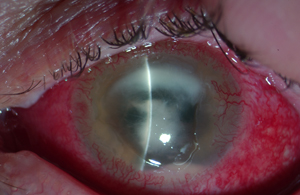
Acanthamoeba keratitis, a rare infection of the eye, damaged the cornea of patient Warren Cline.
Eye safety issues abound for contact wearers

Uyen Tran, M.D.
After 40 years of wearing contact lenses, Warren Cline recently learned that his “casual at best” cleaning practices led to a devastating outcome — the loss of eyesight in his left eye.
“I didn't always use lens solution when cleaning my contacts,” Cline admitted. “I just used regular tap water. I did this off and on for 35-40 years.
The 64-year-old businessman from Huntsville, Ala., was diagnosed a year ago with a disease called Acanthamoeba keratitis, a rare infection of the eye that primarily occurs in people who wear contact lenses. The microscopic protozoan, commonly found in fresh water, invades the cornea, which can result in permanent visual impairment or blindness.
Uyen Tran, M.D., has been treating Cline at the Vanderbilt Eye Institute since March 2007. She says several practices among contact lens wearers that can increase the risk of getting Acanthamoeba keratitis include improper cleaning and handling of lenses, showering, swimming and using hot tubs while wearing lenses, and sleeping in contact lenses.
It is one of the most common infections seen during the spring and summer months.
“Acanthamoeba lives in pools, lakes and the water supply,” said Tran, assistant professor of Ophthalmology and Visual Sciences. “If you wear contact lenses into these areas, the protozoan can get trapped between the contact lens and the eye and form an ulcer that eats through the eye. Those not wearing contact lenses can clear infectious agents from the eye via a natural process of blinking and tearing.
“This infection is rare but devastating. It is difficult to treat, the damage is not reversible, and it can continue to recur.”
With summer in full swing, Tran said it's not just contact lens wearers who should take precautions. Sun and water lovers should consider the following safety tips: wear hats and sunglasses with side shields, and apply sunscreen around the eye for protection. VEI sees many patients for eyelid reconstruction and eye surgery because of injury or damage caused by ultraviolet light exposure.
“UVA and UVB rays not only penetrate the surface of the skin, but also the eyes,” she said. “Sunburn on the eyelids can lead to malignancies such as basal cell, squamous cell and melanoma cancer. Squamous cell carcinoma and melanoma are also seen in and on the eye as well.”
Another common condition due to sun exposure in adults is a pterygium — a growth or “fleshy mass” of scar tissue that can grow over the cornea, causing pain and vision impairment. Populations exposed to high levels of sun — like house painters, gardeners and those living in warmer climates — are most susceptible.
Not all eye injuries are cumulative. A perfect example is a corneal burn, which can be seen in skiers and water-sport enthusiasts. If left untreated, it can lead to scarring and permanent vision loss. Patients experiencing this acute condition will immediately feel intense pain because the cornea has more nerves than any part of the body.
“Dermatology does a great job of educating the masses about sun damage to the skin, and people have really responded to that. They need to take the same precautions with their eyes,” said Tran. “Children are never too young to learn the importance of wearing protective eyewear, hats with wide brims or baseball caps and sunscreen to protect their eyes and vision.”
Cline strongly agrees.
“I have been telling my friends and my children so that they will pass it down to their children,” said Cline, who has also had two cornea transplants in hopes of improving his vision. “I've had kidney stones and broken bones, but I have never experienced that kind of pain. Increasingly reduced vision is a scary thing. We all need to pay more attention to our eyes.”













